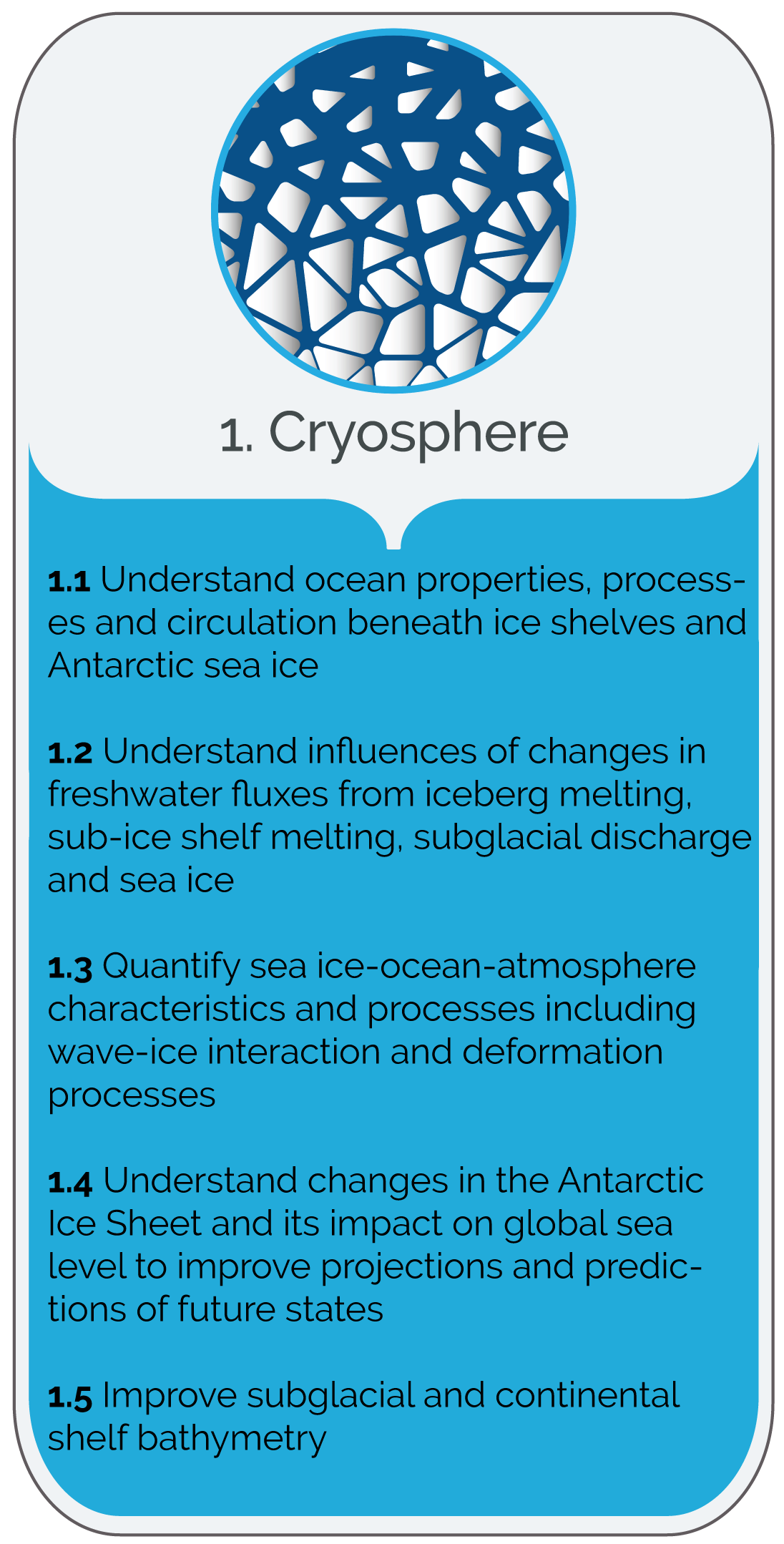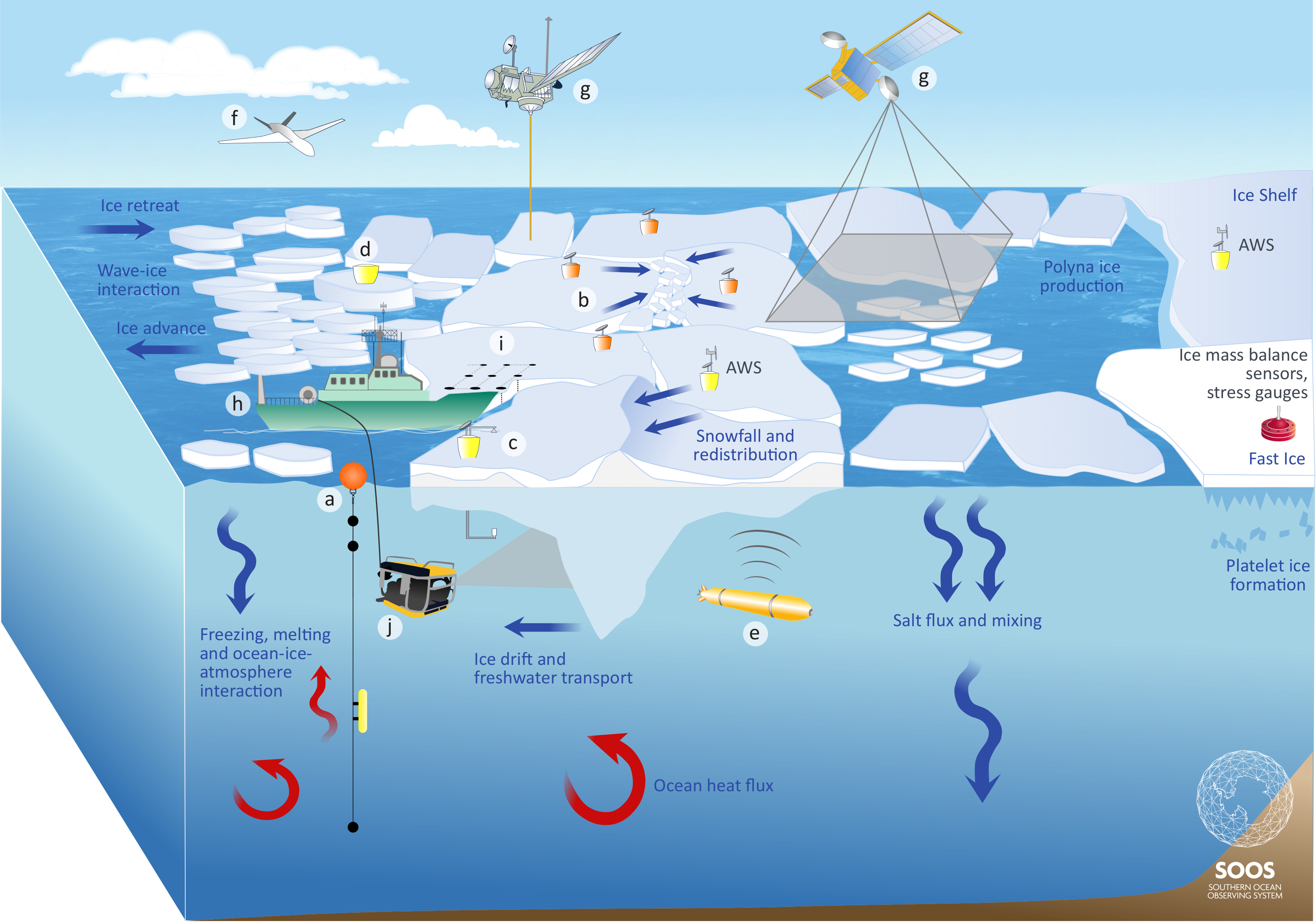
Science Theme 1: Cryosphere

Understanding and quantifying the state and variability of the Southern Ocean cryosphere
The components of the cryosphere that are present in or interact with the Southern Ocean are: the sea ice and its snow cover; icebergs; marine terminating glaciers; and ice shelves. Current climate projections of future sea-level rise to 2100 range from 0.45 m to 1.7 m, and more accurate future projections require better understanding of ice shelf-ocean interactions. Observations indicate an increase in ocean-driven ice shelf basal melt during the last decade. The increased glacial meltwater input to the Southern Ocean has consequences for its stratification, growth and melt of sea ice, and heat transport onto the continental shelves.
Sea ice, which covers an area of the Southern Ocean ranging seasonally from about 3 million km2 to 19 million km2, is key to modulating ocean-atmosphere fluxes; impacts glacial ice discharge and ice shelf stability; mediates biogeochemical processes; contributes to the formation of water masses that are key for ocean uptake of anthropogenic heat and carbon; and provides a habitat for many important marine species. The increase then decrease of Antarctic sea ice extent in 2012 and 2016, respectively, followed by recovery to above approximately historic mean values in 2020, exemplifies the complexity of the ocean-sea ice-atmosphere system, which is not represented adequately in either forecast or climate models.
Observing the cryosphere where it interacts with the ocean is key to understanding change in the ocean. Under ice shelves the lack of bathymetric data, knowledge of ice shelf draft, observations of ice-ocean interactions, and water mass modification and ocean current measurements, limit the characterisation of the ocean dynamics, long-term trends (e.g., ocean warming) and variability. Knowledge gaps in sea ice thickness, motion, deformation, floe-size distribution, snow depth, and feedback between sea ice variability and glacial ablation, inhibit reliable quantification and modelling of the relevant interaction processes impacting the Southern Ocean and the Antarctic Ice Sheet. Relevant feedback processes between ice shelves, icebergs and sea ice, both via the ocean and atmosphere are also needed to improve description and quantification.
Key Science Challenges
1.1: Understand ocean properties, processes and circulation beneath ice shelves and Antarctic sea ice with emphasis on:
-
Variability in space and time modulation by sea ice and the role of polynyas
-
Sea ice loss and change in ice sheet mass balance
-
Heat transfer and freshwater flux between sea ice/ice shelf and ocean
1.2: Understand influences of changes in freshwater fluxes from iceberg melting, sub-ice shelf melting, subglacial discharge and sea ice
1.3: Quantify sea ice-ocean-atmosphere characteristics and processes including wave-ice interaction and deformation processes to understand:
-
The driver of change and variability in the volume, properties, floe-size and distribution of Antarctic sea ice and consequent impacts on atmospheric and oceanic properties and circulations
-
Changes in sea ice extent, thickness and volume over seasonal, annual, decadal, and millennial timescales
-
Change and variability in the Antarctic fast ice belt and its role in protecting glacier/ice shelf fronts, polynya formation/maintenance and water mass modification
1.4: Understand changes in the Antarctic Ice Sheet and its impact on global sea level to improve projections and predictions of future states
1.5: Improve subglacial and continental shelf bathymetry

Addressing Challenges
Delivery of the knowledge and scientific outputs that will address these challenges is carried out by SOOS alone, but by many community efforts, including the programs and projects of SCAR and SCOR, among others. SOOS will not duplicate the efforts of these programs, but will support them where appropriate, to enhance the collection and delivery of the required data. Click below for a list of key community efforts to address these challenges:







